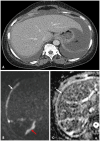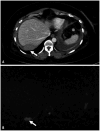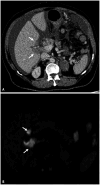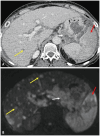CT and MRI in Advanced Ovarian Cancer: Advances in Imaging Techniques
- PMID: 40873375
- PMCID: PMC12394823
- DOI: 10.3348/kjr.2025.0357
CT and MRI in Advanced Ovarian Cancer: Advances in Imaging Techniques
Abstract
Ovarian cancer (OC) remains one of the leading causes of gynecologic cancer-related mortality, with most patients presenting with disseminated disease, particularly within the peritoneal cavity. Standard treatment includes cytoreductive surgery, platinum-based chemotherapy, and targeted maintenance approaches depending on the patient's and tumor's genetic profile. Despite treatment advancements, approximately 25% of high-grade serous OC cases relapse within a year despite optimal primary treatment with complete tumor clearance at cytoreduction. Advances in contrast-enhanced CT (CE-CT) and MRI have revolutionized the evaluation and treatment planning of advanced OC. CT remains the gold standard for staging and assessing tumor extent, effectively identifying peritoneal, lymphatic, and distant metastases. However, it is less effective in detecting small-volume peritoneal dissemination. MRI, with superior soft-tissue contrast, complements CT by providing a detailed assessment of peritoneal disease, characterizing sonographically indeterminate adnexal masses. Diffusion-weighted imaging and gadolinium-enhanced MRI have improved the diagnostic sensitivity for peritoneal disease but are unable to predict treatment response, recurrence risk, and prognosis. Radiomics, which extracts quantitative tumor features from imaging data, holds promise for personalizing treatment and identifying patients at risk for early recurrence despite optimal therapy. The integration of CT, MRI, and radiomics could enhance surgical planning and improve long-term survival outcomes in patients with advanced OC.
Keywords: CT; Lexicon scoring; MRI; Ovarian cancer; Radiomics.
Copyright © 2025 The Korean Society of Radiology.
Conflict of interest statement
The authors have no potential conflicts of interest to disclose.
Figures
















Similar articles
-
Ovarian cancer staging and follow-up: updated guidelines from the European Society of Urogenital Radiology female pelvic imaging working group.Eur Radiol. 2025 Jul;35(7):4029-4039. doi: 10.1007/s00330-024-11300-7. Epub 2025 Jan 11. Eur Radiol. 2025. PMID: 39798005 Free PMC article.
-
Optimal primary surgical treatment for advanced epithelial ovarian cancer.Cochrane Database Syst Rev. 2011 Aug 10;2011(8):CD007565. doi: 10.1002/14651858.CD007565.pub2. Cochrane Database Syst Rev. 2011. PMID: 21833960 Free PMC article.
-
Prescription of Controlled Substances: Benefits and Risks.2025 Jul 6. In: StatPearls [Internet]. Treasure Island (FL): StatPearls Publishing; 2025 Jan–. 2025 Jul 6. In: StatPearls [Internet]. Treasure Island (FL): StatPearls Publishing; 2025 Jan–. PMID: 30726003 Free Books & Documents.
-
Taxane monotherapy regimens for the treatment of recurrent epithelial ovarian cancer.Cochrane Database Syst Rev. 2022 Jul 12;7(7):CD008766. doi: 10.1002/14651858.CD008766.pub3. Cochrane Database Syst Rev. 2022. PMID: 35866378 Free PMC article.
-
123I-MIBG scintigraphy and 18F-FDG-PET imaging for diagnosing neuroblastoma.Cochrane Database Syst Rev. 2015 Sep 29;2015(9):CD009263. doi: 10.1002/14651858.CD009263.pub2. Cochrane Database Syst Rev. 2015. PMID: 26417712 Free PMC article.
References
-
- World Health Organization. Globocan 2022 (version 1.1) - 08.02.2024. [accessed on January 31, 2025]. Available at: https://gco.iarc.fr/tomorrow/en/dataviz/trends?types=0_1&sexes=2&mode=po....
-
- Sung H, Ferlay J, Siegel RL, Laversanne M, Soerjomataram I, Jemal A, et al. Global cancer statistics 2020: GLOBOCAN estimates of incidence and mortality worldwide for 36 cancers in 185 countries. CA Cancer J Clin. 2021;71:209–249. - PubMed
-
- Prat J FIGO Committee on Gynecologic Oncology. Staging classification for cancer of the ovary, fallopian tube, and peritoneum. Int J Gynaecol Obstet. 2014;124:1–5. - PubMed
Publication types
MeSH terms
Substances
Grants and funding
LinkOut - more resources
Full Text Sources
Medical

